We'll start with some interesting news on crime:
"Where can I get a bag?" there has been a recent spate of arrests involving marijuana use here in Japan, most notably being the two sumo wrestlers that were arrested. If I understand correctly, it is not illegal to cultivate marijuana in Japan if you are a Shinto priest. It's not that Shinto advocates the smoking of marijuana, but the use of the plant is necessary for certain ritual purposes. By far, the most abused drugs in Japan are alcohol and amphetamines. In fact, amphetamines were such a problem in the wake of the War in the Pacific that it is illegal to have over the counter cold medicines like Nyquil or Sudafed here because of their potential use in manufacturing meth.
The Elderly Life of Crime - Japan's population is becoming lopsided, with the fastest-growing section of the population being those over the age of 65. Meanwhile, fewer and fewer babies are being born. This means that the university system here is becoming bankrupt, and that health care and social security measures for the elderly are being eroded because the State is reducing the funding for these programs. In response, more and more of the elderly are becoming criminals. I am having hard time finding a better example of why poverty is such a major concern. Typically poverty looks like distended bellies in a remote part of the globe, but the reality is that poverty is pernicious and ubiquitous. And sometimes a rational response to poverty is crime. Being a prisoner here provides not only three hots and a cot, but it also provides a reliable schedule of tasks to be completed and a consistent relationship between those that are jailed and those that treat them within the criminal justice system. Many of these criminal elderly lack precisely these cornerstones to personhood as conceived here in Japan.
Google and the Battle for Nihongo - Google Trends, that fun-filled zeitgeist site is doing well here in Japan. I think it's really interesting to see the rise of English education in Japan and the concomitant rise in katakana-izing Japanese. For those that don't know, the Japanese have a special syllabary (they don't use an alphabet, but combinations of consonants and vowels) so that they can recreate the sounds of foreign languages. As an example my name is Paul but the Japanese don't have an "L" sound in their syllabary so to get as close as they can to my name it becomes Po-Ru. Once you know how to read katakana you would be amazed at how much you can get done here in Japan. That doesn't mean that you can write very much, though. For reading and speaking, katakana is very powerful; for writing and more "adult" reading you must really know hiragana and kanji. Hiragana are the native Japanese syllabary, taken from Chinese characters, and it is from these that katakana are developed. Kanji are the Japanese versions of Chinese characters (hanji). Kanji are awesome for communicating complicated ideas and are simply necessary to be considered as educated as a high school student. But, katakana are used to communicate foreign words (and so, ideas) and this exoticism is tres chic among the younger Japanese. So, even native things get katakana-ized but there is the potential erosion of the use of kanji which is a star in the constellation of cultural artifacts, like Shinto, or natto, that makes the Japanese "Japanese." This "Japanese"-ness is a constant talking point among the Japanese. As an American it's hard for me to relate because when I learn about America I learn about 250 years - the Japanese learn about a period that is nearly ten times as long.
Mail-a-Squid - It seems counter-intuitive that a society that stresses the collective as the Japanese do should simultaneously be so fanatical about the local. The best paradigm for understanding this phenomena (again, part of what makes Japan so "Japanese") is Thomas Kasulis' Intimacy or Integrity. In the above article we learn about the Wakayama Prefecture's fishing cooperative that is trying to promote interest in their region by selling New Year's (a family time like Thanksgiving and Christmas combined) greeting cards made out of dried squid. Dried squid is like the beef jerky of America - ubiquitous.
And Speaking of Processed Meats That Are Ubiquitous in Okinawa - Aww, Spam. The world economy is in a profound shift (which looks like apocalypse for Wall Street) and when the U.S. has to tighten its belt, it also buys a ton of canned meat. This canned meat tendency goes wherever poorer Americans go and Okinawa has become a major Spam-eating center.
Monday, November 17, 2008
Friday, November 14, 2008
Nago's Pineapple Park!

Back in May we had some guests visit from overseas. We took them to the best place we could think of: Nago's Pineapple Park. Classic.
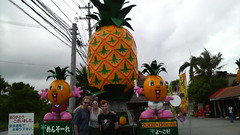
You get there and can take an electric golf cart from the future which drives itself around a field of pineapples while you are guided by "Pineapple herself" telling you interesting things about pineapples.
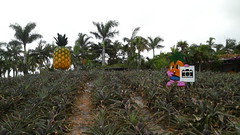
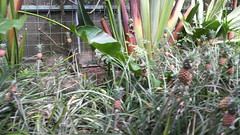
Then you get bombarded with pineapple products. The wine ain't all bad, but this is something you want to share with a lot of people so that you only have to drink a little. The best was the pineapple white chocolate.
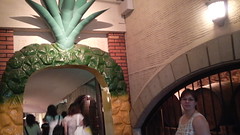
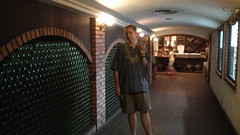

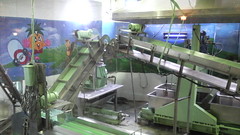
Two Things I Saw That I Wouldn't See in the States

I've long harbored a desire to be a new member of the Beastie Boys, and while driving through Naha I thought I'd found my chance when I saw:
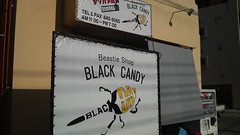
Black Candy, Beastie Shop.
Unfortunately it has nothing to do with the Beastie Boys and everything to do with Japanese fighting beetles! These were some of the coolest looking bugs I've ever seen, and they were hundreds and hundreds of dollars! Every year in the mainland there is a big tournament where the kids can have their beetles wrestle. Apparently these tournaments are a source of financial loss for many in the Ryukyus.
The other thing I saw here recently that I know I won't see in the U.S. any time soon was this:

This is the paper place mat that comes on the food tray your given at MOS Burger. MOS is like a WholeFoods-meets-McDonalds kind of fast food chain. If you click on the image and look closely you will see that not only are there all sorts of trivia questions on this mat, but there's even a geometry problem. I was so embarassed at my complete lack of ability in mathletics.
Making Glass at Onna Glass
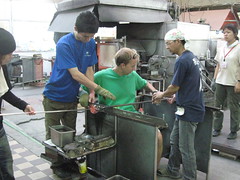
We went to the Onna Glass Factory on 58 in Onna-son and I've got photos to show it!
Okinawa is known for its beach glass, Ryukyuan glass I think I've heard it called. In any touristy-shop worth its sea salt you should find at least 10 pieces of glass made here in the Okinawa. I'm not totally fluent in communicating the aesthetics of glass but I can tell you how I understand Ryukyuan glass, which is to say it seems to be generally rustic but the master glass makers here also create amazing sculptures and abstract compositions - way better than Chihuly's stuff that was all over Atlanta for so long.
A lot of the glass I see here is pretty playful, which was what I was hoping to be able to get when we went to the shop. Word to the wise, bring a friend that can communicate in Japanese because there are a number of things you can do at the shop. When you arrive you are greeted by what looks like the gift shop, but is actually the staging area for your experience. Throughout this room are glass works in different shapes and colors and dimensions. The size and color largely determine the cost of the glass making experience.
I chose blue because it's cheap and also because that's the color I think of most when I think Okinawa. I chose to make one that was pretty playful and really not much bigger than a standard "rocks" glass at a bar. It had several divets put into it that accomodated my fingers nicely - ergonomic, but not nerdy; relaxed. Shinpai shinai de, ii sa! Which is the most complicated thing I can say in Uchinaguchi (the indigenous Okinawan language), it means, basically, don't worry, everything will be okay. That's what this cup told me.
So, you walk in and you realize just how committed you have to be to the artform to do this in Okinawa: it's crazy hot in the factory! Crazy hot.

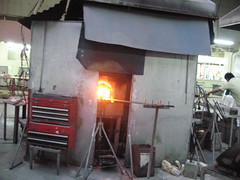
This was another one of many experiences I've had here in Okinawa where I am allowed to do really UNSAFE things with minimal concern. Like walking around these blast furnaces wearing shorts and flip flops.
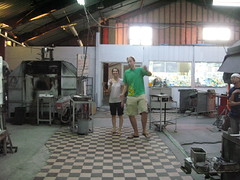
But don't worry, you really can't hurt yourself because you will be surrounded by, like, a dozen people. Sometimes I felt like I was being corralled by the artisans, bringing a depth of meaning to the old phrase, "like a bull in a china shop."
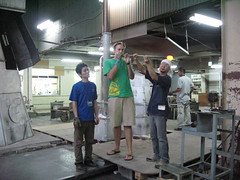


After you've gone through the several steps for making your piece, they put the glass into a furnace that is less hot than where it can slowly cool over the next 12 hours or so. This way it doesn't shatter. You can pick it up from them the next day.
Kumejima!
We went to beautiful Kumejima last month to run the 10k portion of their annual marathon. I cannot recommend enough to those of you in the area this race. Hands-down this was the most generous race I've participated in: we were given really nice technical shirts (not the usual cotton tshirt), each of us got a bottle of Kumesen awamori, we got free cookies, and we were given a coupon for 400 yen to use in the food booths after the race was finished. Nice!
Kumejima is west of Okinawa honto, we took the Kumejima ferry from the port in Naha and the trip was about 3 hours. This is a great ferry ride because you pass several other isladns, like Tokashiki and so it feels nice and scenic.
The ferry leaves the port around 8:30 and arrives in Kumejima around noon. We checked into a nice place that had two seperate guest houses. Ours was closer to the Eefu イフ beach and had two seperate rooms and boathrooms. The rooms were just down the street from an internet cafe/video/moped rental place, Lucky Gate.
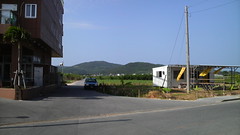 (ain't much in Kumejima)
(ain't much in Kumejima)
Heads-up for lunch: the restaurants in the staging area all keep seperate lunch and dinner hours. That means you should really put your stuff down in the hotel and get to a restaurant before they close at 1pm. We found a nice place, just down from Lucky Gate (my only point of reference now) that was open after 1:30 and we had what chicken tastes like:
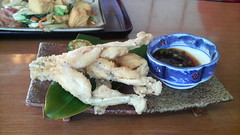
We went down to the beach but the coral had all died out (which is becoming increasingly true around the islands). That said, the water was like a bath and the nearby hilss made it quite scenic. I later noticed after my swim the sign that warns about warm water=more jellyfish. Not that I'm saying ignore these signs, but, I've only seen one jellyfish in the Okinawa area during my snorkelings around the island. I think the signs should be heeded, but not keep you from swimming.
On the way back from the beach I saw a couple of bits of grafitti from GUN, who seems to own the entire Ryukyuan Kingdom.
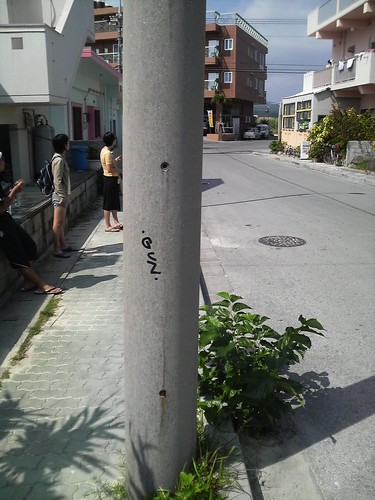
We tried to rent a moped so we could explore the island, but the number of tourists running the race the next day meant that there were no mopeds for us. So, we rented a car and drove around the island. I really dropped the ball and didn't take nearly enough pictures while we were there (which was really only 24 hours). Kumejima has a large number of traditional wooden houses in the Ryukyuan style and they're just gorgeous to take in. If you've been to Ryukyu Mura (the traditional Ryukyuan village theme park) and been inside these homes in the summer you know how awesome they are. Driving around I even saw an owl.
One of the coolest things I've seen in nature has to be the Kumejima Tatami Ishi. These are cross sections of volcanic basalt columns that look like neatly-arranged tatami or turtle carapaces:
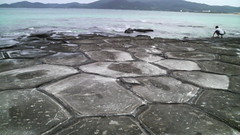
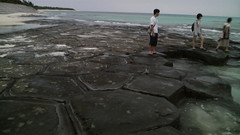
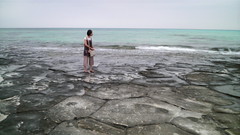
There are much better pictures of these online, so I recommend googleing them.
I learned later that after the Japanese took control of the Ryukyu Kingdom during the 19th century they exiled many of the royals to Kumejima.
Kumejima is west of Okinawa honto, we took the Kumejima ferry from the port in Naha and the trip was about 3 hours. This is a great ferry ride because you pass several other isladns, like Tokashiki and so it feels nice and scenic.
The ferry leaves the port around 8:30 and arrives in Kumejima around noon. We checked into a nice place that had two seperate guest houses. Ours was closer to the Eefu イフ beach and had two seperate rooms and boathrooms. The rooms were just down the street from an internet cafe/video/moped rental place, Lucky Gate.
 (ain't much in Kumejima)
(ain't much in Kumejima)Heads-up for lunch: the restaurants in the staging area all keep seperate lunch and dinner hours. That means you should really put your stuff down in the hotel and get to a restaurant before they close at 1pm. We found a nice place, just down from Lucky Gate (my only point of reference now) that was open after 1:30 and we had what chicken tastes like:

We went down to the beach but the coral had all died out (which is becoming increasingly true around the islands). That said, the water was like a bath and the nearby hilss made it quite scenic. I later noticed after my swim the sign that warns about warm water=more jellyfish. Not that I'm saying ignore these signs, but, I've only seen one jellyfish in the Okinawa area during my snorkelings around the island. I think the signs should be heeded, but not keep you from swimming.
On the way back from the beach I saw a couple of bits of grafitti from GUN, who seems to own the entire Ryukyuan Kingdom.

We tried to rent a moped so we could explore the island, but the number of tourists running the race the next day meant that there were no mopeds for us. So, we rented a car and drove around the island. I really dropped the ball and didn't take nearly enough pictures while we were there (which was really only 24 hours). Kumejima has a large number of traditional wooden houses in the Ryukyuan style and they're just gorgeous to take in. If you've been to Ryukyu Mura (the traditional Ryukyuan village theme park) and been inside these homes in the summer you know how awesome they are. Driving around I even saw an owl.
One of the coolest things I've seen in nature has to be the Kumejima Tatami Ishi. These are cross sections of volcanic basalt columns that look like neatly-arranged tatami or turtle carapaces:



There are much better pictures of these online, so I recommend googleing them.
I learned later that after the Japanese took control of the Ryukyu Kingdom during the 19th century they exiled many of the royals to Kumejima.
Food Security in Japan
I got this video from Matt Armstrong's awesome public diplomacy blog, MountainRunner.
Subscribe to:
Posts (Atom)
